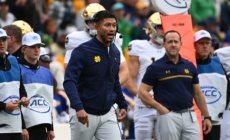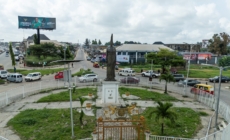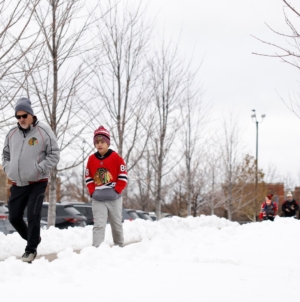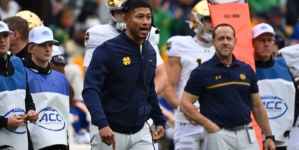-
Winter storm warnings for 6 states as 10 inches of snow to hit - 7 mins ago
-
Hong Kong Holds Vote as Officials Move Against ‘Anti-China’ Elements - 13 mins ago
-
Kirk Herbstreit Predicts Bad News for Notre Dame as CFP Selection Looms - 43 mins ago
-
Hong Kong Man Arrested After Posting Online About Deadly Fire - 58 mins ago
-
Zac Gallen Predicted To Sign $135M Deal With NL Club Despite Cubs Rumors - about 1 hour ago
-
How Has Congestion Pricing Changed Your Year? - 2 hours ago
-
Ancient African city rises from ashes of colonialism - 2 hours ago
-
Fire in Goa, India, Kills at Least 25 - 2 hours ago
-
Warriors HC Steve Kerr Rips Into Two Players With Team Struggling - 2 hours ago
-
Alabama’s Kalen DeBoer Makes Clear Case for CFP After Loss to Georgia - 3 hours ago
How ‘No Kings’ Protests Can Take the Next Step | Opinion
Now regarded as one of the largest recorded mass mobilizations in American history, the 7 million people who showed up for this month’s No Kings protest surpassed the millions of Americans who turned out in June for its first iteration. And with more mobilizations planned for this fall, the United States is joining the ranks of social movements globally, which are witnessing an increase in activity this year.
September, in particular, was a banner month for mass mobilization and protest around the world.
The Philippines witnessed tens of thousands of Filipinos flooding the streets for days to protest government corruption and misuse of funds intended for flood control projects. Nepal’s anti-corruption protests mobilized tens of thousands of young Nepalis, also for multiple days, to decry mismanagement of public funds. The United Kingdom’s anti-genocide protest movement witnessed hundreds of Londoners getting arrested for supporting Palestinian rights. Serbia saw tens of thousands occupy the streets, demanding justice and protesting populist rule. Mozambique’s mobilization against autocracy gained traction, Argentina’s mass protests against femicide went mainstream, and Indonesia’s civil unrest over economic frustrations came to a head. Most of these cases weren’t single-day mobilizations, but sustained protests in public spaces.
That was all just in September. The world is afire with protest. People are fed up with governments that are corrupt, cruel, unjust and violent, and they’re rising up. The United States also witnessed its fair share of mobilization this year, but it hasn’t yet grown into the kind of sustained mass mobilizations on display in the Philippines, Nepal, Indonesia or Serbia. The major ingredients are all there: the corruption, the cruelty, the injustice and the violence towards citizens. The history of mass mobilization is also there: the U.S. has a rich history of sustained mass protest to win civil rights, voting rights, marriage rights and more. And the appetite is there: many Americans are looking for ways to nonviolently engage, resist and protest.

What’s missing in the U.S., then, that’s present in the Philippines, Nepal, Indonesia or Serbia? Some might argue that for middle America conditions are not yet painful enough, socially or economically, to inspire sustained noncooperation. Others might argue that resistance on social media provides a cathartic outlet, allowing users to feel like they’re resisting without having to engage in sustained protest or economic boycott and noncooperation. There’s also no strategic plan or national campaign in place that assures nonviolent resisters that their involvement is part of a grand strategy. If there were, there’d be safety in numbers and a sense of efficacy. If they’re going to get arrested for nonviolent resistance, they want it to be part of a larger game plan.
This last point makes sense, and it resonates with me as well. Growing up in the Amish and Mennonite tradition, which are peace churches, I’ve been a lifelong conscientious objector of war, a professional peacebuilder and daily promoter of nonviolence. My heroes are leaders who have spent their lives nonviolently resisting corrupt, cruel, unjust and violent regimes. I’ve written and spoken about them in the past, hoping that I could serve society in similar ways. And yet, if I’m going to risk arrest in 2025, I want it to be part of a larger strategy.
It’s not only about safety in numbers; it’s also about the effectiveness of those numbers. Quantity and quality. If nonviolent resisters are going to risk their record and reputation, and potentially professional or personal relationships, it had better be for something substantial, sustained and strategic. And it had better be nonviolent, which doubles a campaign’s success rate and lands better in terms of public perception.
The nonviolent action, therefore, must sit within a campaign strategy. Before any action takes place in Washington DC, Los Angeles, Chicago or Portland, an assessment of the conflict landscape is essential. It can be as simple as a “SWOT” analysis—strengths, weaknesses, opportunities and threats. Because unless the movement knows where the power lies, protest action has the potential to miss the mark.
That analytical first step informs participants of how to build capacity and power, which is the second step. The Civil Rights Movement implemented extensive workshopping, training and role-playing, which helped build skills for forthcoming actions. Had this essential step been overlooked, those nonviolent actions could’ve derailed.
These two steps—assessing and building—ensure nonviolent actions will have their greatest impact. A protest may not be the thing that accomplishes a movement’s goals. It might, instead, be a boycott or some other form of political, economic or social noncooperation that targets the pillars that prop up a government. In the U.S., single-day protests like No King’s Day have become a default action, but they may not always be the most effective one. Actions that can shift power to the people are needed most right now, but first activists need to understand what those actions are, and how they can be accomplished.
After shifting power to the people—like a year-plus bus boycott can do, for example—and getting the government to lessen its corruption, cruelty, injustice or violence, defending those gains is a must. In Nepal, for example, the Gen Z protests teed up the country’s first-ever female prime minister, former chief justice Sushila Karki. In Mozambique, civil society organizations are involved in a state council that’s helping to organize a multi-party government. These systems-level changes help lock in the wins gained during and after protest actions. And these, too, must be part of a campaign strategy so that if the nonviolent actions are successful, there’s a civilian-based defense mechanism in place to defend those hard-won gains.
If frustrated Americans could trust that all of this was in place—the assessment, the building of capacity and power, the actions to shift power and the civilian-based defense mechanisms—would more patriots get involved? Perhaps. It would certainly help in building confidence in the safety of the numbers and the efficacy of those numbers. Quantity and quality. As things heat up across U.S. cities, a campaign like this might well be the thing that catches the conscience of the would-be king. It’s time to try.
Michael Shank is director of programs at the Albert Einstein Institution and adjunct professor at New York University’s Center for Global Affairs and George Mason University’s Carter School for Peace and Conflict Resolution.
The views expressed in this article are the writer’s own.
Source link




















